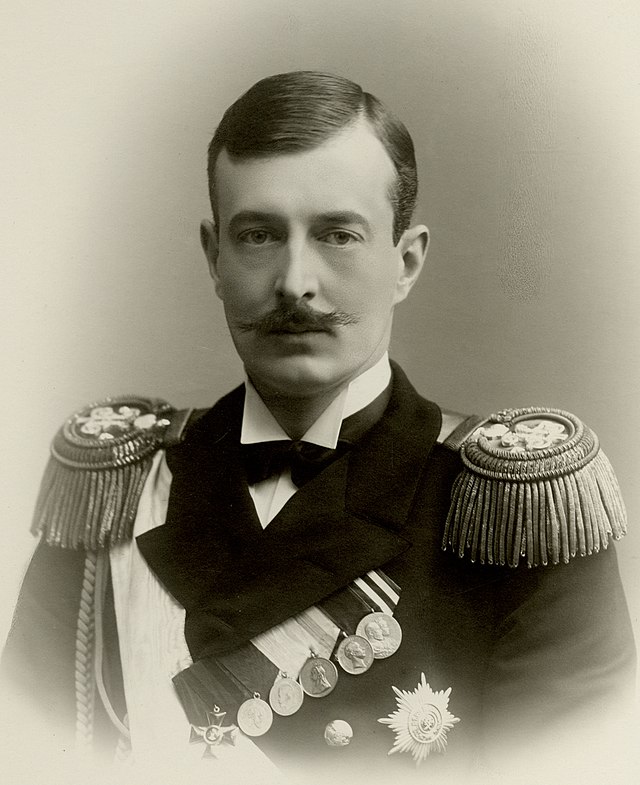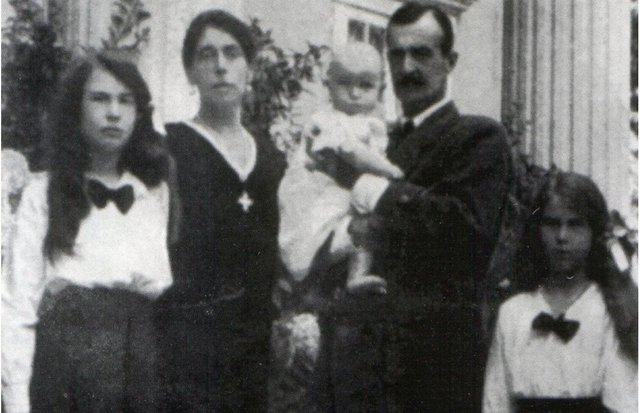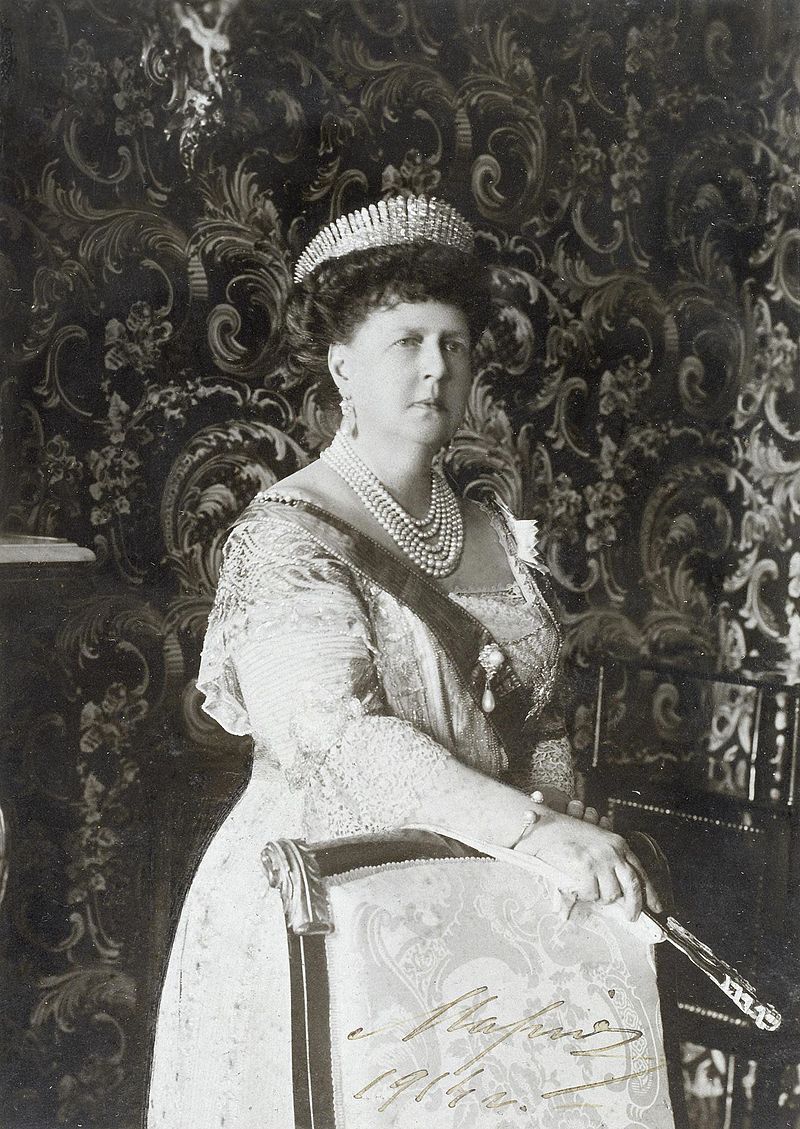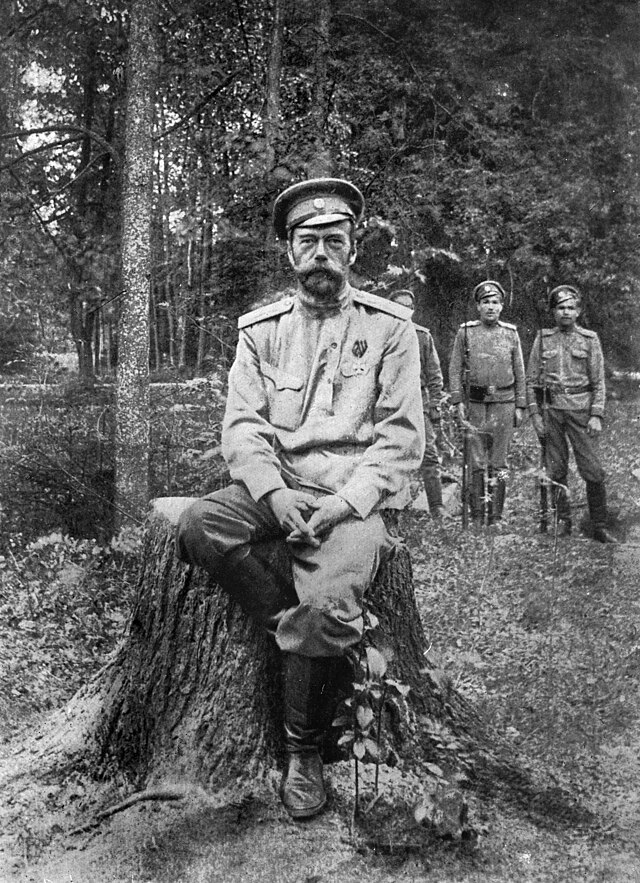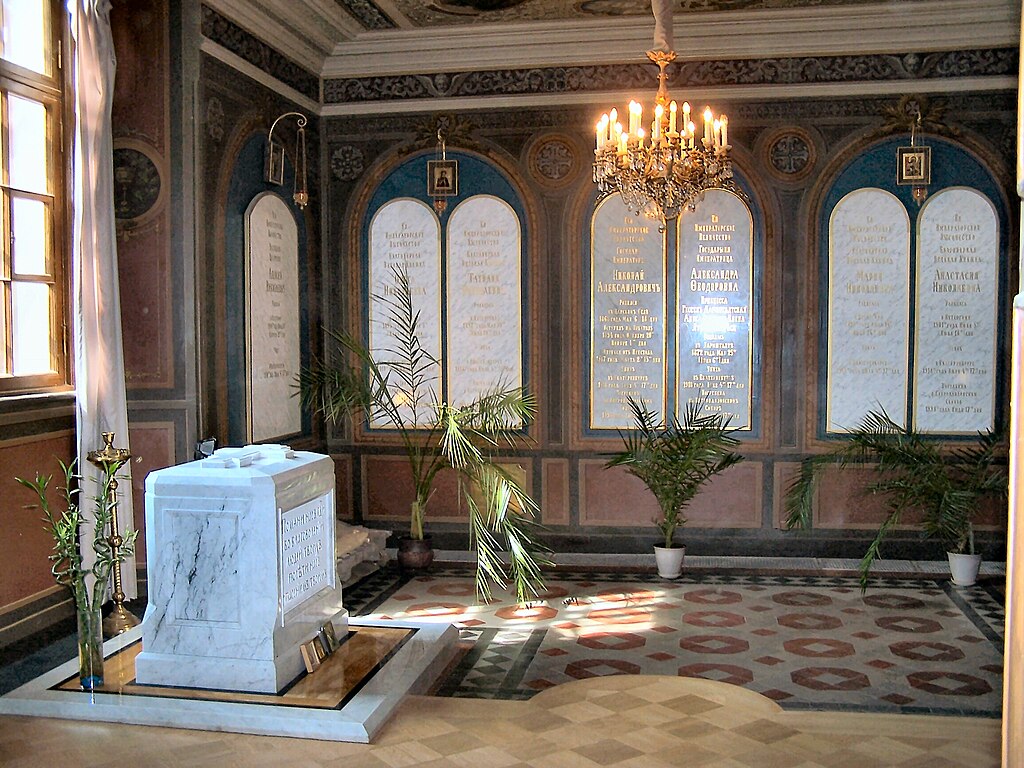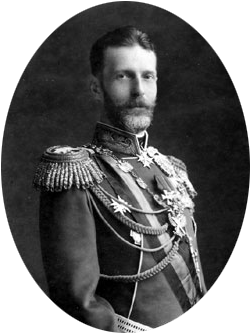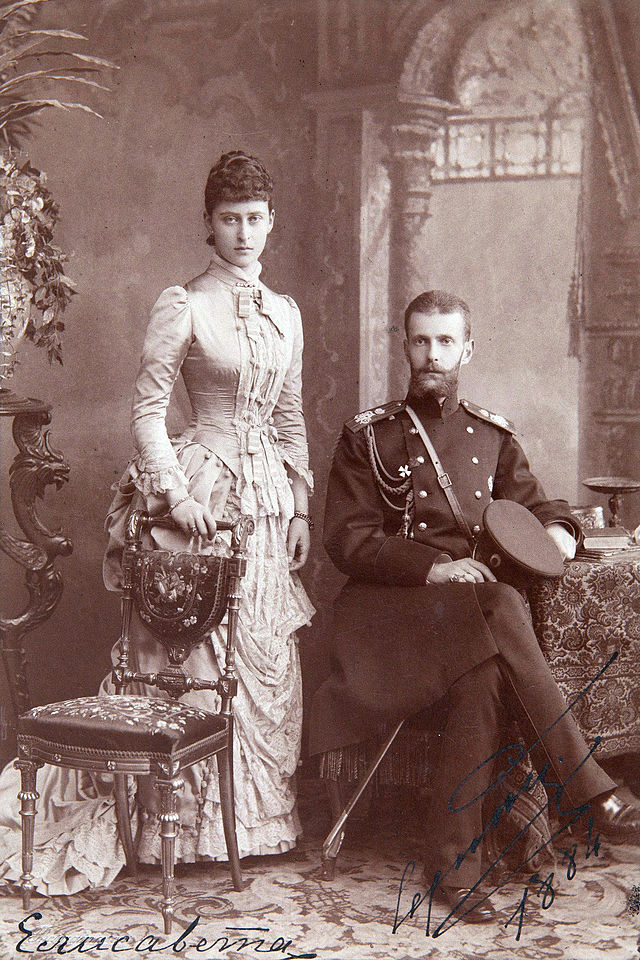by Susan Flantzer © Unofficial Royalty 2016

Marie of Hesse and by Rhine, Maria Alexandrovna, Empress of All Russia; Credit – Wikipedia
Maximiliane Wilhelmine Auguste Sophie Marie, Her Grand Ducal Highness Princess Marie of Hesse and by Rhine, was the first wife of Alexander II, Emperor of All Russia. She was born on August 8, 1824, in Darmstadt, Grand Duchy of Hesse and by Rhine, now in Hesse, Germany. Marie was the youngest child of Wilhelmine of Baden, wife of Ludwig II, Grand Duke of Hesse and by Rhine. She was officially Ludwig’s daughter, but the last four of Wilhelmine’s children were probably the children of August von Senarclens de Grancy, her longtime lover, with whom Wilhelmine had lived since 1820. Wilhelmine and Ludwig had lived apart since 1809.
Marie’s siblings were:
- Ludwig III, Grand Duke of Hesse and by Rhine (1806–1877), married (1) Princess Mathilde Caroline of Bavaria, no issue (2) morganatic marriage, Magdalene Appel, created Baroness of Hochstädten, no issue
- Prince Karl of Hesse and by Rhine (1809–1877), married Princess Elisabeth of Prussia, had issue including Ludwig IV, Grand Duke of Hesse and by Rhine
- Unnamed Prince/Princess of Hesse and by Rhine (born and died 1820)
- Princess Elisabeth of Hesse and by Rhine (1821–1826), died young
- Prince Alexander of Hesse and by Rhine (1823–1888), morganatic marriage to Countess Julia Hauke, had issue including Louis of Battenberg (married Princess Victoria of Hesse and by Rhine, later 1st Marquess of Milford Haven, ancestor of Prince Philip, Duke of Edinburgh), Alexander of Battenberg (Sovereign Prince of Bulgaria) and Henry of Battenberg (married Princess Beatrice, youngest child of Queen Victoria)
Marie’s mother was responsible for her education, and her mother’s preference for French culture and literature was evident in her education which placed a special emphasis on literature and history. When Marie was 11 years old, her mother died and Marianne Gransi, a lady-in-waiting to Marie’s mother, took over the responsibility of Marie’s education.
In 1839, when Marie was 14, the heir to the Russian throne, Alexander Nikolaevich, the Tsarevich, visited Hesse while on a tour of Europe. Alexander fell in love with Marie despite the stigma of her birth. There was already a connection with the Russian Imperial Family. Marie’s maternal great-aunt Louise of Baden (Empress Elizabeth Alexeievna) had married Alexander I, Emperor of All Russia. Alexander Nikolaevich’s mother Empress Alexandra Feodorovna, born Princess Charlotte of Prussia, was against the marriage. In a letter to his mother, Alexander wrote: “I love her, and I would rather give up the throne, than not marry her. I will marry only her, that’s my decision!” Finally, after being persuaded by her husband Nicholas I, Emperor of All Russia, Empress Alexandra Feodorovna went to Darmstadt to meet Marie. The Empress liked what she saw and gave her permission for the marriage.
A Russian Orthodox priest came to Darmstadt and instructed Marie in the Russian Orthodox religion. In September 1840, Marie arrived in Russia and shared her impressions of St. Petersburg in a letter to his family: “St. Petersburg is much more beautiful than I thought. The Neva River is wonderful. I think it is difficult to find a greater city. The view from the Winter Palace on the Neva is wonderful!” Marie was received into the Russian Orthodox Church on December 5, 1840, and became Grand Duchess Maria Alexandrovna. The next day, the official betrothal was held in the presence of the Imperial Family, the whole court, the Russian nobility, many notable foreign guests, and representatives of foreign states.
The wedding took place on April 16, 1841, in the Grand Church of the Winter Palace in St. Petersburg. Maria Alexandrovna wore a white dress richly embroidered with silver and diamonds. Over one shoulder lay a red ribbon and a crimson velvet robe with white satin and fine ermine was fastened on her shoulders. She was bedecked with a diamond tiara, diamond earrings, a diamond necklace, and diamond bracelets. Her future mother-in-law, Empress Alexandra Feodorovna could not resist the desire to decorate the bride’s hair with flowers, the symbols of purity and innocence. The Empress ordered orange blossoms to be brought to her and she stuck them between the diamonds in Maria Alexandrovna’s tiara and pinned a small branch on her chest.

Maria Alexandrovna and Alexander; Credit – Wikipedia
Alexander and Maria Alexandrovna had eight children:
- Grand Duchess Alexandra Alexandrovna (1842 – 1849), died of meningitis at the age of six
- Tsarevich Nicholas Alexandrovich (1843 – 1865), engaged to Dagmar of Denmark (the future wife of his brother Alexander III), died of meningitis at the age of 21
- Alexander III, Emperor of All Russia (1845 – 1894), married Dagmar of Denmark (Maria Feodorovna), had issue
- Grand Duke Vladimir Alexandrovich (1847 – 1909), married Marie of Mecklenburg-Schwerin (Maria Pavlovna), had issue
- Grand Duke Alexei Alexandrovich (1850 – 1908), had illegitimate issue via an affair with Alexandra Vasilievna Zhukovskaya
- Grand Duchess Maria Alexandrovna (1853 – 1920) married, Alfred, Duke of Edinburgh and Saxe-Coburg and Gotha, had issue
- Grand Duke Sergei Alexandrovich (1857 – 1905), married, Elisabeth of Hesse of Hesse and by Rhine (Elizabeth Feodorovna), no issue
- Grand Duke Paul Alexandrovich (1860 – 1919), married (1) Alexandra of Greece and Denmark (Alexandra Georgievna), had issue (2) Olga Karnovich, had issue
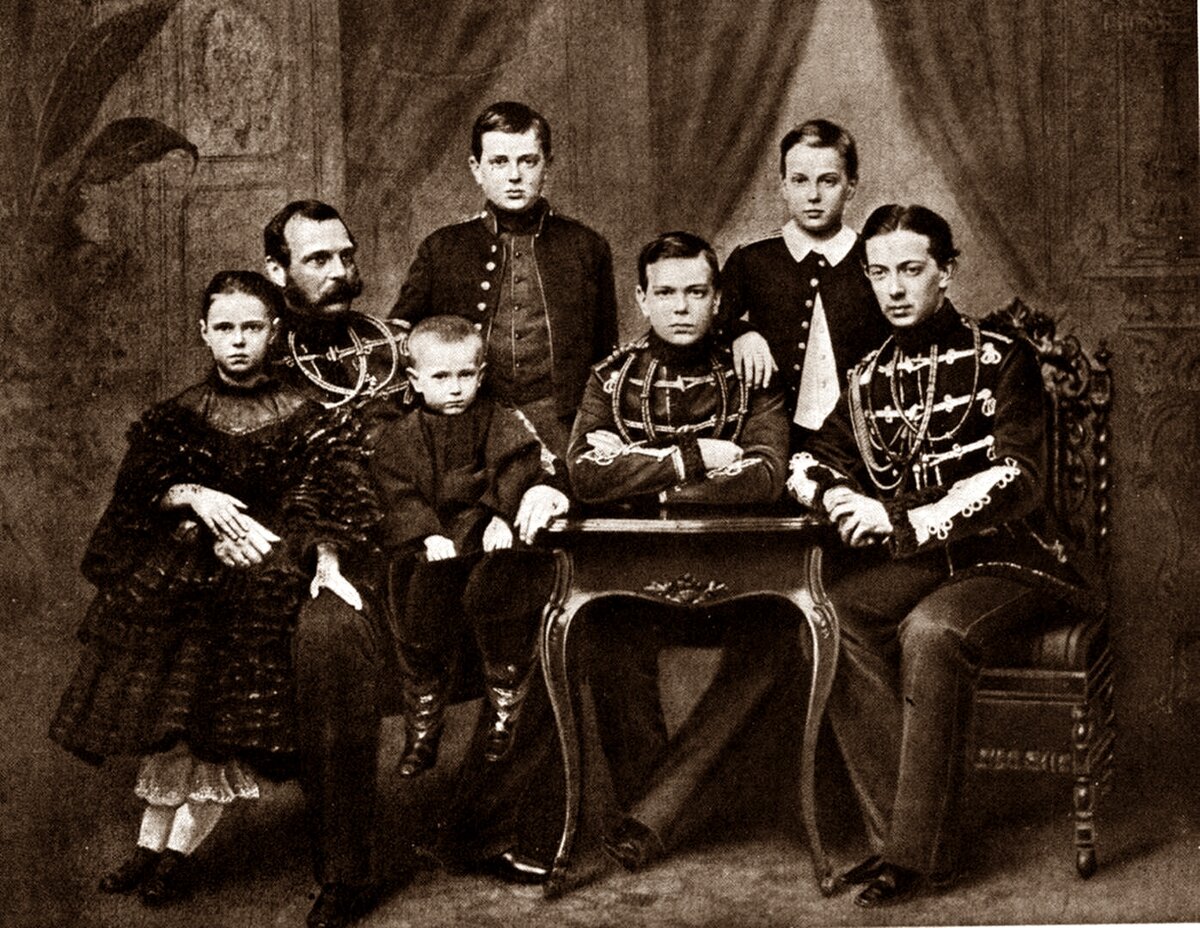
Tsar Alexander II and his children; Photo Credit – Wikipedia
Alexander always treated his wife with respect, but he had numerous mistresses and illegitimate children. His most prominent mistress was Catherine Dolgorukova with whom he had four children. During the last years of Maria Alexandrovna’s life, Catherine and her children lived in the Winter Palace. After his wife’s death, Alexander made a morganatic marriage with Catherine.
In 1855, Alexander became Emperor and Maria Alexandrovna became Empress. During their coronation on August 26, 1856, in the Assumption Cathedral, Moscow Kremlin in Moscow, Russia, the crown fell from Maria’s head, which was seen as a bad omen.

Coronation of Alexander II, Alexander crowns Maria Feodorovna; Credit – Wikipedia
In cooperation with Queen Victoria’s daughter Princess Alice of the United Kingdom, the wife of Ludwig IV, Grand Duke of Hesse and by Rhine who was Maria’s nephew, Maria arranged the marriage of her only daughter Maria Alexandrovna to Queen Victoria’s second son Alfred, Duke of Edinburgh, a marriage that Queen Victoria had resisted.
Maria Alexandrovna had a close relationship with her brother Prince Alexander of Hesse and by Rhine, who had made a morganatic marriage with Countess Julia Hauke, one of his sister’s ladies-in-waiting. Their children were the start of the Battenberg (and later the Mountbatten) family. Maria’s frequent stays at her brother’s Hessian home Schloss Heiligenberg resulted in the subsequent marriage of Maria’s son Grand Duke Sergei Alexandrovich with Princess Elisabeth of Hesse and by Rhine, and also the ultimate marriage of Maria’s grandson Nicholas II, Emperor of All Russia with Princess Alix of Hesse and by Rhine. Both Hesse princesses were granddaughters of Queen Victoria.

Hessian family at Schloss Heiligenberg in 1864, Women: Countess Julia Hauke, Princess Elisabeth of Prussia (wife of Prince Karl), Empress Maria Feodorovna, Princess Alice of the United Kingdom (wife of Prince Ludwig); Men: Prince Karl of Hesse and by Rhine, Prince Wilhelm of Hesse and by Rhine, Prince Ludwig of Hesse and by Rhine (future Grand Duke), Prince Gustaf Wasa of Sweden, Prince Alexander of Hesse and by Rhine; Credit – Wikipedia
In 1863, Maria Alexandrovna contracted tuberculosis. Frequent childbirth, her husband’s infidelity, and the death of her eldest son Tsarevich Nicholas Alexandrovich in 1865 from meningitis at the age of 21, completely undermined Maria’s already weak health. Since the 1870s, Maria had spent the autumn and the fall in the warmer climates of Crimea and Italy. Her health worsened after two assassination attempts on her husband’s life in 1879 and another one in 1880. Empress Maria Alexandrovna died at the Winter Palace in St. Petersburg on June 3, 1880, at the age of 55. She was interred at the Peter and Paul Cathedral in the Peter and Paul Fortress in St. Petersburg. Her husband, who married his mistress Catherine Dolgorukova within a month of Maria’s death, died on March 13, 1881, the victim of an assassination by a bomb that blew off his legs.

Tomb of Alexander II (on left) and Maria Alexandrovna, his wife (on right); Photo Credit – Susan Flantzer
This article is the intellectual property of Unofficial Royalty and is NOT TO BE COPIED, EDITED, OR POSTED IN ANY FORM ON ANOTHER WEBSITE under any circumstances. It is permissible to use a link that directs to Unofficial Royalty.
Romanov Resources at Unofficial Royalty







